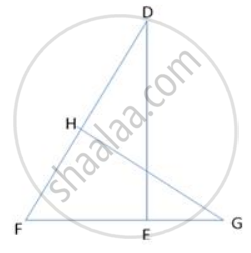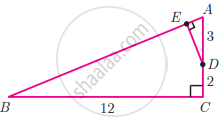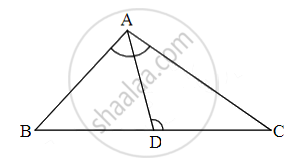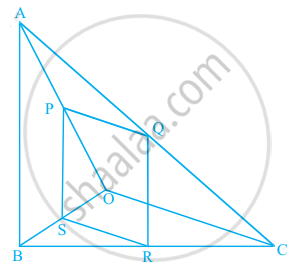Advertisements
Advertisements
Question
In figure , DEF is a right -angled triangle with ∠ E = 90 °.FE is produced to G and GH is drawn perpendicular to DE = 8 cm , DH = 8 cm ,DH = 6 cm and HF = 4 cm , find `("Ar" triangle "DEF")/("Ar" triangle "GHF")`

Solution
ln Δ DEF and Δ GHF,
∠ DEF = ∠ GHF (90 ° each)
∠ DEF = ∠ GHF ...(common)
Δ DEF = Δ GHF ....(AA corollary)
`therefore ("Ar" triangle "DEF")/("Ar" triangle "GHF") = "EF"^2/"HF"^2` ......(1)
[The ration of areas of two similar triangle is equal to the ratio of square of their corresponding sides.]
In right Δ DEF, (By Pythagoras theorem)
DE2 + EF2 = DF2
EF2 = 102 - 82
EF2 = 36
EF = 6
From ( 1),
`("Ar" triangle "DEF")/("Ar" triangle "GHF") = (6/4)^2 = 9/4`
i.e. 9 : 4
APPEARS IN
RELATED QUESTIONS
The diagonal BD of a parallelogram ABCD intersects the segment AE at the point F, where E is any point on the side BC. Prove that DF × EF = FB × FA
Using Converse of basic proportionality theorem, prove that the line joining the mid-points of any two sides of a triangle is parallel to the third side. (Recall that you have done it in Class IX).

O is any point in the interior of ΔABC. Bisectors of ∠AOB, ∠BOC and ∠AOC intersect side AB, side BC, side AC in
F, D and E respectively.
Prove that
BF × AE × CD = AF × CE × BD
Prove that the area of Δ BCE described on one side BC of a square ABCD is one half the area of the similar Δ ACF described on the diagonal AC.
On a map drawn to scale of 1 : 2,50,000 a rectangular plot of land ABCD has the following measurement AB = 12 cm, BC = 16 cm angles A, B, C, and D are 900 each. Calculate:
(i) The diagonal distance of the plot of land in
(ii) Actual length of diagonal.
Two triangles QPR and QSR, right angled at P and S respectively are drawn on the same base QR and on the same side of QR. If PR and SQ intersect at T, prove that PT × TR = ST × TQ
In the adjacent figure, ∆ABC is right angled at C and DE ⊥ AB. Prove that ∆ABC ~ ∆ADE and hence find the lengths of AE and DE
If in triangles PQR and XYZ, `"PQ"/"XY" = "QR"/"ZX"` then they will be similar if
In triangle ABC point D is on side BC (B−D−C) such that ∠BAC = ∠ADC then prove that CA2 = CB × CD

In figure, if PQRS is a parallelogram and AB || PS, then prove that OC || SR.
